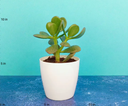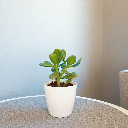Product Specifications
Crassula ovata is a hardy succulent native to South Africa and Mozambique. It is recognized for its thick, glossy, oval-shaped leaves that grow in opposite pairs along the branches. Over time, it can grow into a small shrub or tree, with a woody stem that adds to its bonsai-like appearance. The leaves are typically a rich green; under the right lighting conditions, they can develop a reddish tint along the edges.
This slow-growing plant is highly valued for its aesthetic appeal and symbolic significance in various cultures. In Feng Shui, this Plant is regarded as a symbol of good luck, wealth, and prosperity. It is particularly popular as a houseplant due to its low-maintenance requirements, making it a perfect choice for both beginner and experienced gardeners.
In optimal conditions, Crassula ovata may produce small, star-shaped white or pink flowers, typically during the winter months, although this is relatively rare for indoor plants.
- LowMaintenance: Requires minimal care, ideal for homes and offices.
- Air Purification: Helps to purify indoor air.
- Symbol of Prosperity: Traditionally believed to bring good luck and wealth.
Watering: Water sparingly. Allow the soil to dry completely between waterings. Overwatering can lead to root rot.
Sunlight: Prefers bright, indirect light. Can tolerate some direct sunlight but too much can scorch the leaves.
Soil: Use well-draining soil, ideally a mix designed for succulents and cacti.
Temperature: Thrives in temperatures between 18°C and 24°C. Keep away from cold drafts and frost.
Repotting: Repot every 2-3 years as needed, preferably during spring or early summer.






